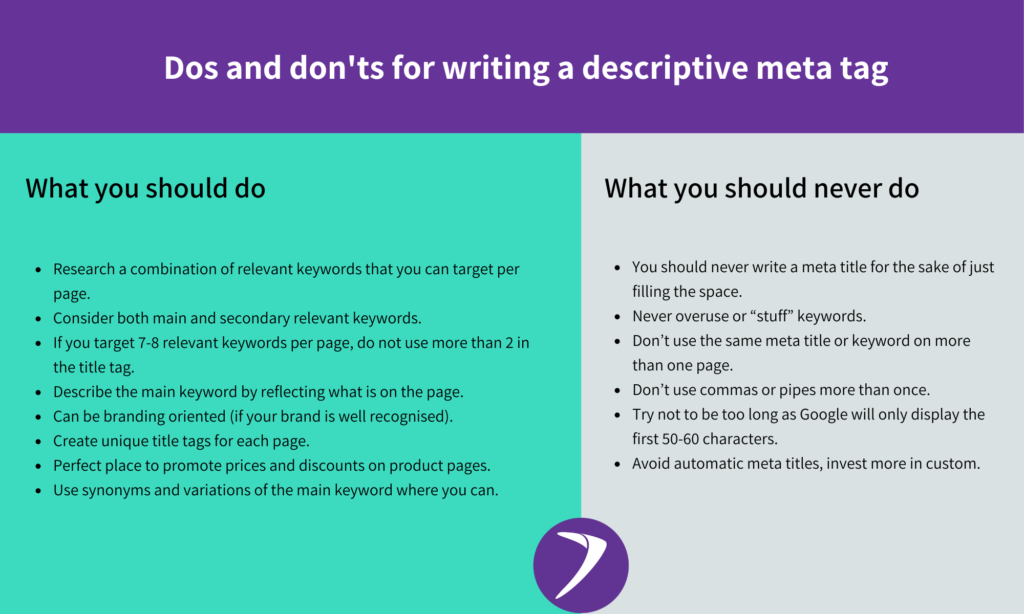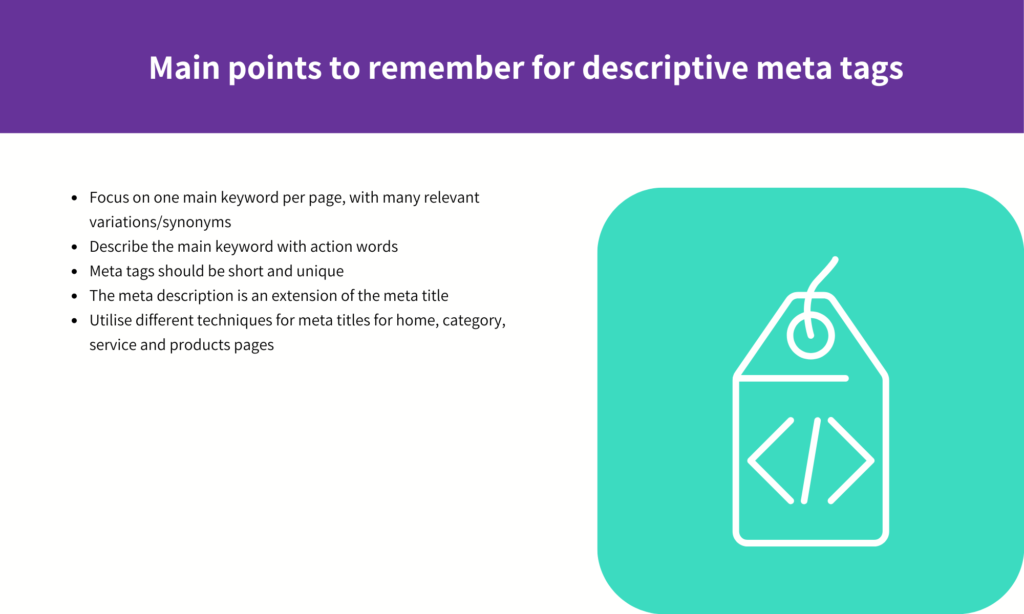How to Create Descriptive Meta Tags
23 June 2023 Blog Posts
Writing descriptive meta tags is very important for your eCommerce website’s SEO.
Meta title tags are displayed as the headline of your website page in search engine results. By crafting descriptive and accurate titles, you will increase the likelihood of attracting clicks from users and will therefore increase your website traffic.
Even though the topic sounds simple, the task is demanding and hard to understand as there are several variations on how to create these meta tags. We will try to bring our experience in and explain what works best by forming some rules and providing real examples.
Confused about what a meta tag actually is? Check out our top 5 tips for what they should include.
Dos and don’ts for writing descriptive meta tags
When writing a title tag, it is important to keep in mind that the title is generally the first content a user will encounter. The goal is to write a title tag in a way that is not only relevant to the content of the page, but also entices the user to click on your search result. You can do this by creating brief, yet descriptive, titles that provide an accurate description of what your page is all about.
What you should never do
- You should never write a meta title for the sake of just filling the space.
- Never overuse or “stuff” keywords.
- Don’t use the same meta title or keyword on more than one page.
- Don’t use commas or pipes more than once.
- Try not to be too long as Google will only display the first 50-60 characters. If you have more than that, don’t worry as you are not getting penalized. Google will still account for the content of the title tag but will not display the full title tag to the user.
- Avoid automatic meta titles, invest more in custom.
What you should do
- Research a combination of relevant keywords that you can target per page.
- Consider both main and secondary relevant keywords.
- If you target 7-8 relevant keywords per page, do not use more than 2 in the title tag.
- Describe the main keyword by reflecting what is on the page.
- Can be branding oriented (if your brand is well recognised).
- Create unique title tags for each page.
- Perfect place to promote prices and discounts on product pages.
- Use synonyms and variations of the main keyword where you can.

How to write descriptive meta title tags with examples
Who doesn’t love their fresh fruits and vegetables? For the sake of providing examples, we are going to look at creating a brand new website selling fruit online! During this blog series we will use our fruits example, so you can understand more of what we are trying to explain. So, imagine a scenario of opening an online fruit shop, selling all sorts of fruits (bananas, apples, oranges, etc).
A typical eCommerce website consists of a home page, categories, products, services and blog pages. Each one targets different traffic and, for the examples below, we will try to explain how to write a meta title for the home page only. We are going to use that scenario throughout the series, so will explain everything specifically for each page type. This brand new online fruit shop will be called Frop! Note, Frop is not a keyword, but a brand name.
We will do some research and find the best relevant keywords that we can target on the home page. Our limited findings are: fruits, fruits online, fruits for sale, fruits for sale online, fruits store. As a starter we must determine the website’s main focus and what target market we can aim for without repeating it throughout the site.
Our virtual shop’s domain name is www.frop.com.au
Meta Title 1: Fruits: Bananas, Apples, Oranges and many more | Frop
We don’t recommend this meta title as you have multiple non relevant keywords displayed. Bananas, Apples, Oranges should have their own pages and shouldn’t be promoted/displayed on the home page title. With this example, the home page will compete with relevant keywords on the apple page which can confuse search engines when finding the most relevant page for certain keywords. The Home page is your most general page and should target keywords based on this. Your biggest benefit of this approach will be if you manage to convince Google to rank both the home page & category page.
Meta Title 2: Fruits | Fruits for sale online | Frop
The title is relevant and short but too generic in our opinion. It reflects what the website is about, but has no call to action for the user. Remember that the title tag serves a purpose for search engines but should also entice the user to click on your search result. There are also multiple pipes used in this example and looks more like stuffing keywords rather than a descriptive title.
Meta Title 3: Fruits | Frop
This is a simple, yet awesome title if your brand is well recognised – usually successful, but for a limited number of sites. We won’t recommend it for most websites, as it is very short and we can better utilise the space to cover more of our website’s content as well as to provide more value to our appearance in the SERPs.
Meta Title 4: Fruits Online – Delicious Fresh Fruits Distributed Daily | Frop
We personally like this title for two reasons. The main focus is not necessarily just the keyword “fruits,” as somebody looking for fruits could just be looking for information that usually can be found on Wikipedia sites. Plus, the competition is massive for this and is the wrong target. “Fruits online” is the correct target, less searches, but more relevant and beneficial to the business. This title also has an action – as somebody looking to buy fruits is looking for fresh products distributed daily. This descriptive title could provide a better CTR due to that.
Meta Title 5: Fruits | Online Shopping | Frop
Usually owners/agencies make mistakes choosing massive search terms and thus end up neglecting the relevancy factor. The keyword “Online Shopping” might be relevant to this site as it is an online shop, but that is about it. The truth is, that the keyword provides very little value to search engines. On another note, when we see titles like this, we can generally guess that they are automatically generated – which generally follow the pattern of a page name, main keyword and brand name. These automatically generated meta titles often repeat on each page. Beware of repetitive meta titles! It’s always best to invest the time to create unique and relevant meta titles.
On certain sites, by just changing meta titles we have seen better CTR for 15-20%
NOTE: Meta titles don’t affect the rankings directly, but are strong indicators for crawlers to find what is on the page. However meta titles are very important and affect other parameters, related to user’s behaviour.
How to write meta description tags with examples
Once you figure out the right meta title, the meta description is just an extended version of the meta title. There is no right or wrong meta description if you are able to focus on describing the main keyword and the content of the page accurately. When writing a meta description, you can try to repeat the main keyword two to three times in relevant variations/synonyms which can help to create an effective description for both search engines and users to understand. It is important to keep in mind that the description should be utilised in a way that is meant to prompt a user to take action. That action, of course, is to click on the search result for your page.
Following this scenario, in our opinion, the right meta description should be:
Meta Description 1: Find fresh fruits for sale online from Australia’s #1 online fruit store. It’s like having a farmer’s market right in your own home! We deliver delicious fresh fruit Australia wide and guarantee the best quality with every order.
In the above example, we were able to target several relevant keywords (Fresh Fruits For Sale, Online Fruit Store, Fresh Fruit, fruit store, fruit Australia etc) while also writing the description in a way that accurately summarizes the page’s content. Most importantly, we have written the description in a way that entices the user to click on the search result.
Check out some more top tips for writing descriptive meta tags from our expert SEO Project Managers.
How to write descriptive meta keyword tags with examples
This is the most controversial of all. Google hasn’t touched on this subject it in their SEO Guide, which means they are neglecting it. However we have a different experience and opinion on that matter. If you try to spend some time researching you are going to find a lot of controversial debate on whether it is important to consider them or not.
This is our theory; Google is 100% ignoring the tag, which means if you have that tag it doesn’t contribute positively or negatively to the search rankings. Google used to value the meta keywords tag in the past and started to ignore it due to the fact that everyone was simply abusing it. Everyone was using this tag to stuff the same keywords across the website.
However, we know that meta tag is in the W3C html validation rules. Google didn’t invent the tag, but the World Wide Web Consortium. The tag is still valid and suggested to be used in the html body. How we use it and for what purpose is different thing. While Google may ignore it, it’s possible that the next search engine won’t ignore it. We use that meta tag in all of our projects and have seen zero negative impact so far. We encourage you to use it, as definitely won’t harm you if used properly.
Following the scenario, in our opinion, the right meta keywords for the Frop Home page should be:
Meta Keywords 1: “fruits, fruits online, fruits for sale, fruits for sale online, fruits store”
Main points to remember for descriptive meta tags
- Focus on one main keyword per page, with many relevant variations/synonyms.
- Describe the main keyword with action words.
- Meta tags should be short and unique.
- The meta description is an extension of the meta title.
- Utilise different techniques for meta titles for home, category, service and products pages.

Take the time to evaluate your current meta tags and determine if you are utilising the right strategy. If you’ve already identified that you’re not reaching your true online potential, and want to grow your organic traffic, then don’t hesitate to get in contact with the Megantic team for a personalised review of your situation and online potential.
You may also be interested in canonical tags. Learn what they are and why you might need them for your eCommerce site.





